Trump Trade War 2025 And Its Impact On Forex Markets



Editorial Note: While we adhere to strict Editorial Integrity, this post may contain references to products from our partners. Here's an explanation for How We Make Money. None of the data and information on this webpage constitutes investment advice according to our Disclaimer.
Trump trade war refers to the tariffs and trade barriers imposed by former U.S. President Donald Trump on key trading partners like China, Canada, and Mexico. The latest measures include a 25% tariff on Canadian and Mexican imports and a 10% tariff on Chinese goods. It aimed to reduce trade deficits and protect U.S. industries but led to retaliatory tariffs, supply chain disruptions, and market volatility.
In early February 2025, President Donald Trump escalated global trade tensions by imposing sweeping Trump tariffs on Canada, Mexico, and China. The latest measures include a 25% tariff on Canadian and Mexican imports and a 10% tariff on Chinese goods.

This new phase of the Trump trade war has already sent shockwaves through financial markets, causing volatility in major Forex pairs like USD/CAD, USD/MXN, and EUR/USD. With retaliatory tariffs from affected nations and ongoing supply chain disruptions, investors and traders must navigate a rapidly shifting economic landscape.
Key developments in Trump’s 2025 trade war
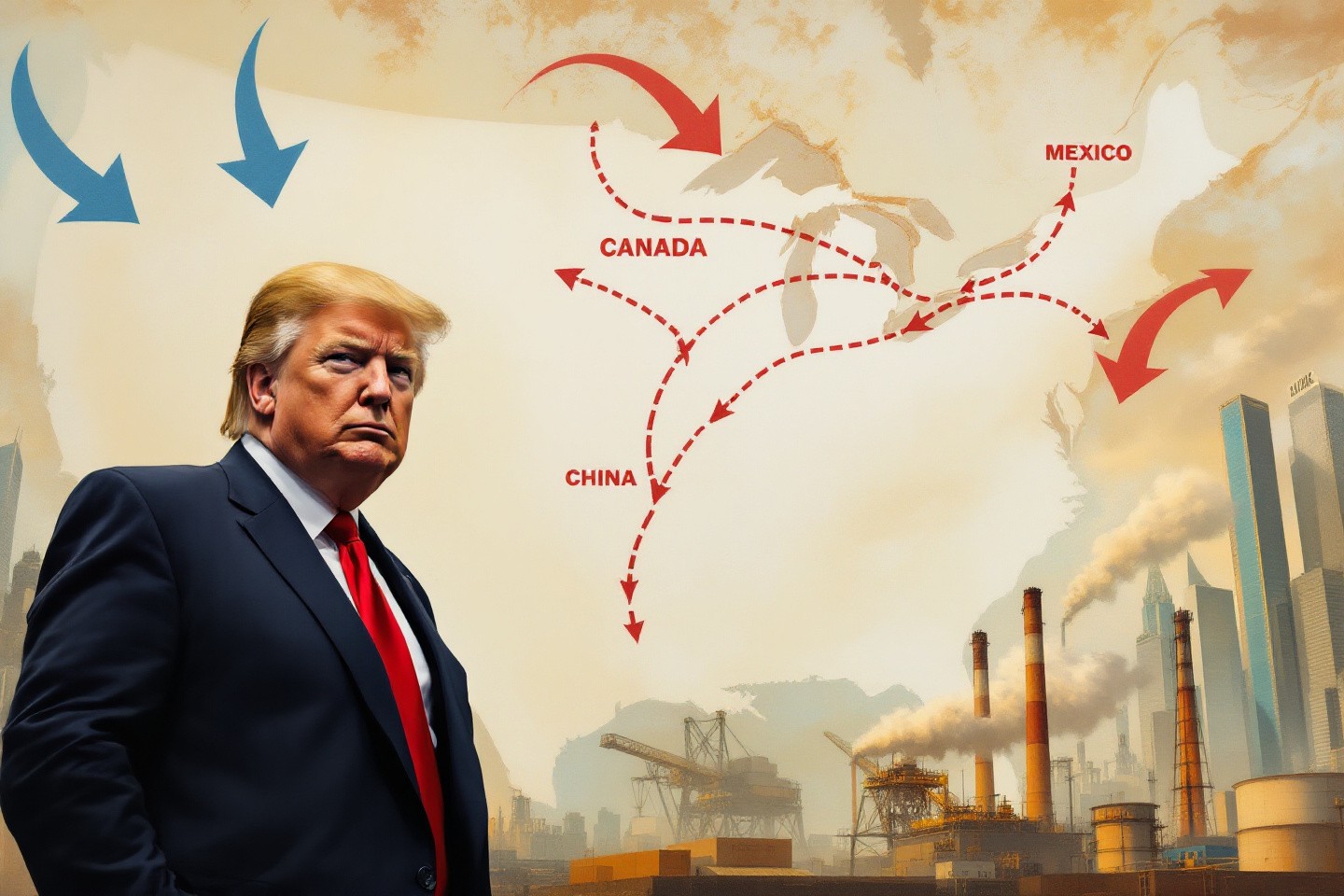
This round of trade war policies is part of Trump’s broader protectionist strategy to reduce trade deficits and bring manufacturing jobs back to the U.S. However, the effects have been far-reaching:
Tariff imposition. The U.S. imposed a 25% tariff on imports from Canada and Mexico and a 10% tariff on Chinese goods, citing national security concerns.
Stock market declines. Major indices like the Dow Jones and S&P 500 dropped as investors reacted to uncertainty in trade policies.
Retaliatory tariffs. Canada imposed countermeasures on $155 billion worth of U.S. goods, targeting lumber, plastics, and consumer products. Mexico introduced tariffs on American agricultural exports and key manufacturing goods. China announced countermeasures, including legal action at the World Trade Organization (WTO) and potential restrictions on rare earth exports.
Supply chain disruptions. Industries relying on imported raw materials — such as automotive, manufacturing, and technology — are experiencing increased costs and logistical challenges.
Currency volatility. The Forex market saw sharp movements in key currency pairs. CAD/USD - the Canadian dollar weakened due to trade uncertainty. MXN/USD - the Mexican peso depreciated as investors feared economic slowdown. EUR/USD - the euro declined as European markets reacted to trade instability.
Rising consumer prices. The cost of goods, including electronics, automobiles, and food, increased due to higher import costs.
Business reactions. U.S. businesses, especially in the agriculture and manufacturing sectors, raised concerns over profitability and supply chain disruptions.
Political criticism. Republican lawmakers expressed mixed opinions, with some supporting protectionist policies while others worried about inflation. Democrats warned that tariffs would increase household costs and strain U.S. trade relations.
International diplomatic strain. U.S.-Canada relations hit a low point as both countries exchanged trade restrictions. Mexico's government expressed frustration, urging negotiations instead of trade barriers. China retaliated by increasing restrictions on U.S. companies operating in Chinese markets.
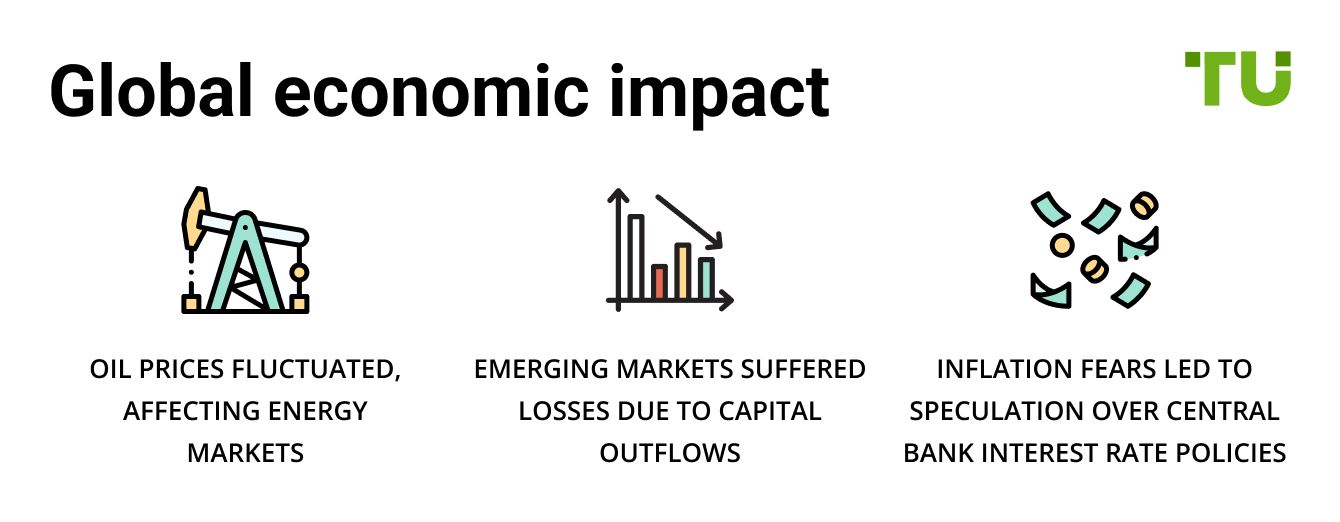
How Trump’s tariffs affected Forex markets
Forex traders are witnessing significant movements across major currency pairs due to the unfolding Trump trade war.

USD/CAD (U.S. Dollar/Canadian Dollar)
Immediate market reaction
After the tariff announcement, the U.S. dollar strengthened while the Canadian dollar fell. The USD/CADpair climbed to around 1.4700, the highest level since 2003.
Key drivers of USD/CAD movement
Trade concerns. The tariffs are expected to hurt Canadian exports to the U.S., making them less competitive. This could reduce export volumes and widen Canada’s trade deficit, weighing on the Canadian dollar.
Oil price impact. Canada’s economy is closely tied to oil prices. A slowdown in global trade could push oil prices lower, which historically weakens the Canadian dollar.
Investor sentiment. Uncertainty over the tariffs has led investors to move funds into safer assets like the U.S. dollar, boosting its value against the Canadian dollar. Learn why crypto is crashing today and the impact of Trump's trade war on the cryptocurrency markets.
Bank of Canada’s response
To counter potential economic weakness, the Bank of Canada cut its key interest rate by 25 basis points to 3%. Lower interest rates tend to make a currency less attractive to investors, adding further pressure on the Canadian dollar.
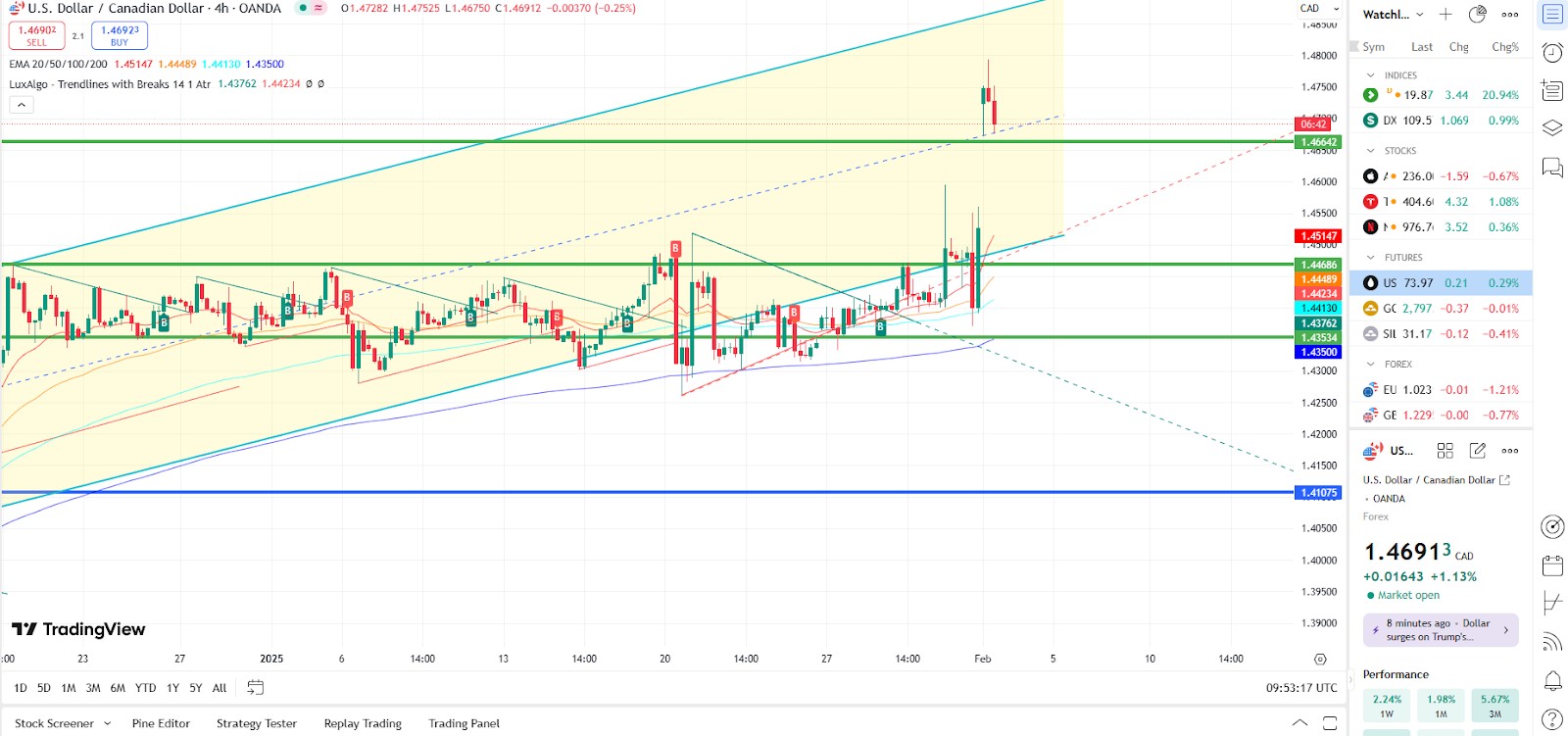
Latest usdcad News

The Canadian dollar surged to its highest level in over five months on Friday, pushing USD/CAD below the critical $1.38 mark amid heightened trade tensions and broad U.S. dollar weakness. At the time of writing, the pair was trading near...
USD/MXN (U.S. Dollar/Mexican Peso)
Immediate market reaction
The announcement of Trump's 25% tariff on Mexican imports led to an immediate reaction in the Forex market, with the Mexican peso dropping by over 2% against the U.S. dollar. This sharp decline pushed the USD/MXN exchange rate above 21.00, marking its highest level since early 2023. Investors responded by shifting funds into the U.S. dollar, which is considered a safer asset during periods of uncertainty. This increased demand for USD further strengthened its position while the peso faced heavy selling pressure, leading to heightened volatility in the Forex market.
Factors Influencing the USD/MXN Movement
Trade balance concerns. The newly imposed tariffs are expected to make Mexican exports to the U.S. more expensive, potentially reducing demand and adversely affecting Mexico's trade balance. This scenario exerts downward pressure on the peso.
Investor sentiment. The tariffs have heightened market uncertainty, leading investors to seek safer assets like the U.S. dollar. This shift in sentiment has contributed to the peso's depreciation.
EUR/USD (Euro/U.S. Dollar)
Immediate market reaction
Following the announcement of a 25% tariff on imports from Mexico and Canada, and a 10% duty on China, the U.S. dollar strengthened as investors sought safe-haven assets amid escalating trade tensions. This surge in demand for the dollar led to a decline in the euro's value against the U.S. dollar. The EUR/USD pair dropped by over 1%, reaching levels around 1.0248, marking its lowest point since November 2022.
Factors Influencing EUR/USD Movement
Safe-haven demand. The tariffs heightened global trade uncertainties, prompting investors to move towards the U.S. dollar, perceived as a safer asset during economic instability. This shift increased the dollar's value relative to the euro.
Economic outlook. The European economy, already facing challenges, is anticipated to be adversely affected by the new tariffs. Concerns over a potential slowdown in Eurozone economic growth have further pressured the euro.
Interest rate differentials. The prospect of higher inflation in the U.S. due to tariffs could lead the Federal Reserve to maintain or increase interest rates, enhancing the dollar's appeal. Conversely, the European Central Bank may adopt a more accommodative stance to support growth, potentially weakening the euro.
Market Sentiment
Analysts express concerns that the escalating trade tensions could lead to a global economic slowdown, with the Eurozone being particularly vulnerable due to its export-oriented economy. The tariffs are expected to disrupt supply chains and increase costs for European exporters, further weighing on the euro.
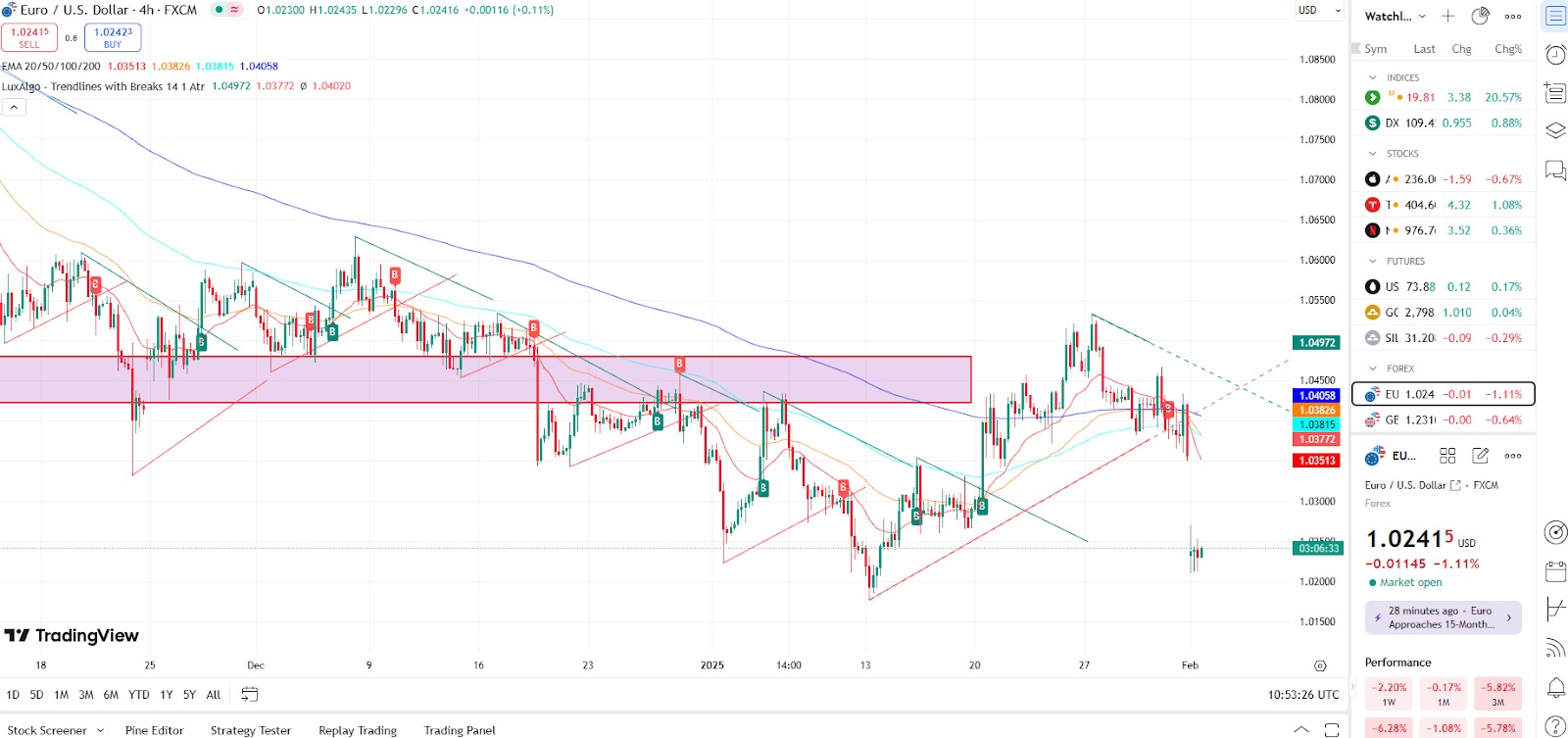
Latest eurusd News

The euro fell below 1.1650 on Tuesday, breaking a key ascending trendline and signaling a shift in short-term momentum for EUR/USD. The pair is now trading near 1.1616, with price action decisively below the 20, 50, and 100 EMAs on the 4-hour...
How Trump’s Trade War affects the U.S. economy
Trump’s recent tariffs on imports from Canada, Mexico, and China are affecting the U.S. economy in several ways. The 25% tariff on goods from Canada and Mexico and the 10% tariff on Chinese imports are expected to increase costs for businesses and consumers.
Rising consumer prices
Higher import costs mean that everyday items like food, electronics, and cars will likely become more expensive. Businesses importing from these countries will either absorb the costs or pass them on to consumers, leading to inflation. Items like avocados, beer, and iPhones are expected to see noticeable price increases.
Business impact and supply chain disruptions
Many U.S. industries rely on materials and parts from these countries. The tariffs may force businesses to find new suppliers, increase production costs, or even move operations. Some companies may shift production back to the U.S., but this would take time and could lead to higher prices due to labor costs.
Stock market reaction
Financial markets have responded with volatility. Investors worry about the long-term impact of tariffs on corporate profits and economic growth. The uncertainty has led to a sell-off in stocks, with major indices declining. Investors have moved to safer assets like the U.S. dollar, which has strengthened as a result.
Jobs and economic growth
Some economists estimate that the tariffs could lead to job losses, especially in industries that depend on exports or imported raw materials. Higher costs for businesses could slow hiring, and if consumers cut back on spending due to rising prices, economic growth may slow further.
Trade relations and retaliation
Canada and Mexico have announced retaliatory tariffs on U.S. goods, increasing pressure on American exporters. If trade tensions escalate, it could weaken U.S. trade relationships and disrupt international markets.
Impact of Trump’s Trade War on Canada, Mexico, and China
President Trump's recent imposition of tariffs — 25% on imports from Canada and Mexico, and 10% on Chinese goods — has significantly impacted the economies and currencies of these nations.
Canada
The Canadian dollar (CAD) weakened following the tariff announcement. The U.S. is Canada’s largest trading partner, and the 25% tariff raised concerns about reduced demand for Canadian exports, particularly in the automotive and manufacturing sectors. This decline in export demand put pressure on the CAD. Additionally, Canada’s retaliatory tariffs on U.S. goods, worth $155 billion, introduced further economic uncertainty, leading to further depreciation of the currency.
Mexico
The Mexican peso (MXN) faced significant losses as markets reacted to the tariffs. The 25% tariff on Mexican imports created fears of reduced export revenues, particularly in industries such as auto manufacturing and agriculture, which are highly dependent on U.S. trade. Investors anticipated slower economic growth in Mexico due to falling export volumes, leading to a sell-off of the peso. Mexico’s decision to implement retaliatory tariffs against U.S. goods added more uncertainty, further weakening the MXN.
China
The Chinese yuan (CNY) dropped to record lows after the U.S. announced tariffs on Chinese imports. The trade war increased concerns about China’s export-driven economy, with expectations of reduced trade volumes and economic slowdown. Investors pulled away from the yuan, opting for safer assets like the U.S. dollar. China’s preparation of countermeasures, including legal action at the World Trade Organization, created additional instability, worsening the currency’s decline.
In response to Trump's tariffs, Canada and Mexico are imposing tariffs on US goods, thus "trade wars" are gaining momentum, which may cause volatility surges. Our expert Anton Kharitonov commented on this situation:
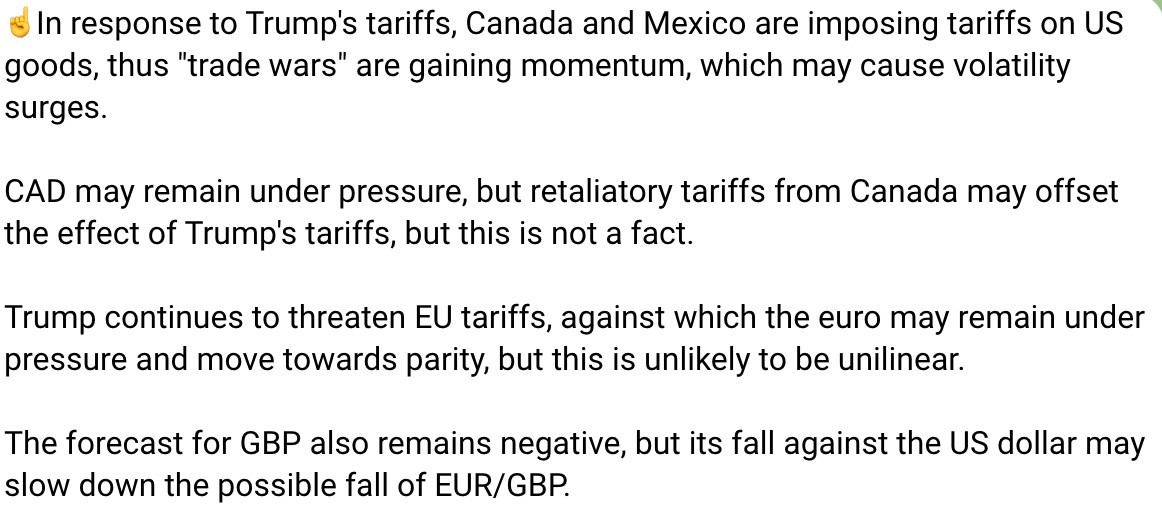
Criticism and reactions to Trump’s Trade War
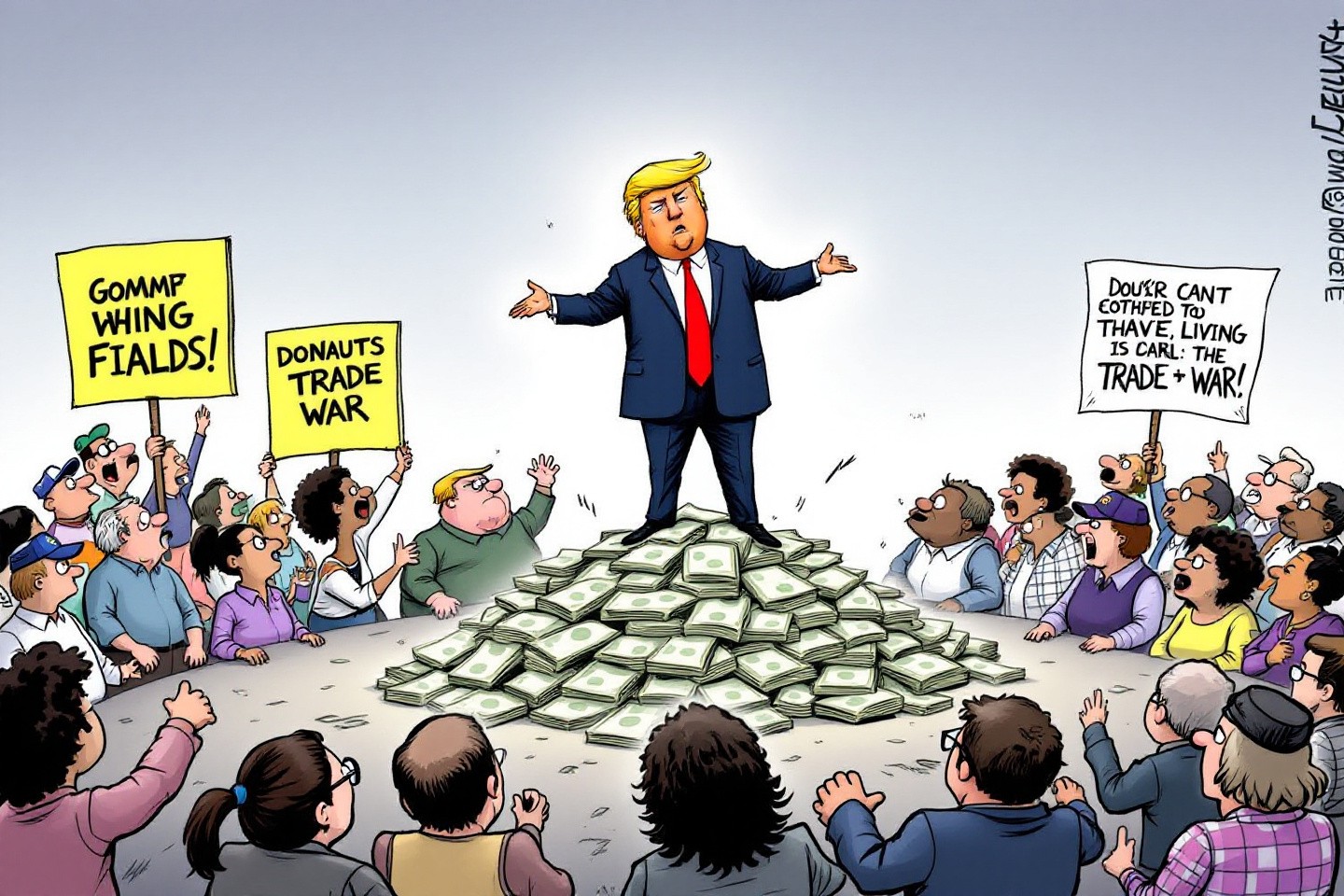
Trump’s recent tariffs on imports from Canada, Mexico, and China have drawn sharp reactions from political figures, economists, and international leaders.
Political reactions

Senator Rand Paul (Republican) opposed the tariffs, stating. “Tariffs are simply taxes.” He warned about the economic impact on American consumers.
Senator Lindsey Graham (Republican) supported the tariffs, seeing them as a necessary measure to address illegal immigration and drug trafficking.
Senator John Barrasso (Republican) expressed optimism, aligning with the administration’s protectionist approach.
Senator Chuck Schumer (Democrat) criticized the tariffs, arguing they would raise costs for American consumers and worsen inflation.
Economic perspectives
Larry Summers, former Treasury secretary, called the tariffs counterproductive. He warned that they could lead to higher prices and make North American companies less competitive.
International responses
Mike Pompeo, former Secretary of State, defended the tariffs, saying they were needed to counter unfair trade practices, especially by China.
Prime Minister Justin Trudeau of Canada announced retaliatory tariffs on U.S. goods worth $106 billion. He stated that while regrettable, they were necessary to protect Canada’s economy.
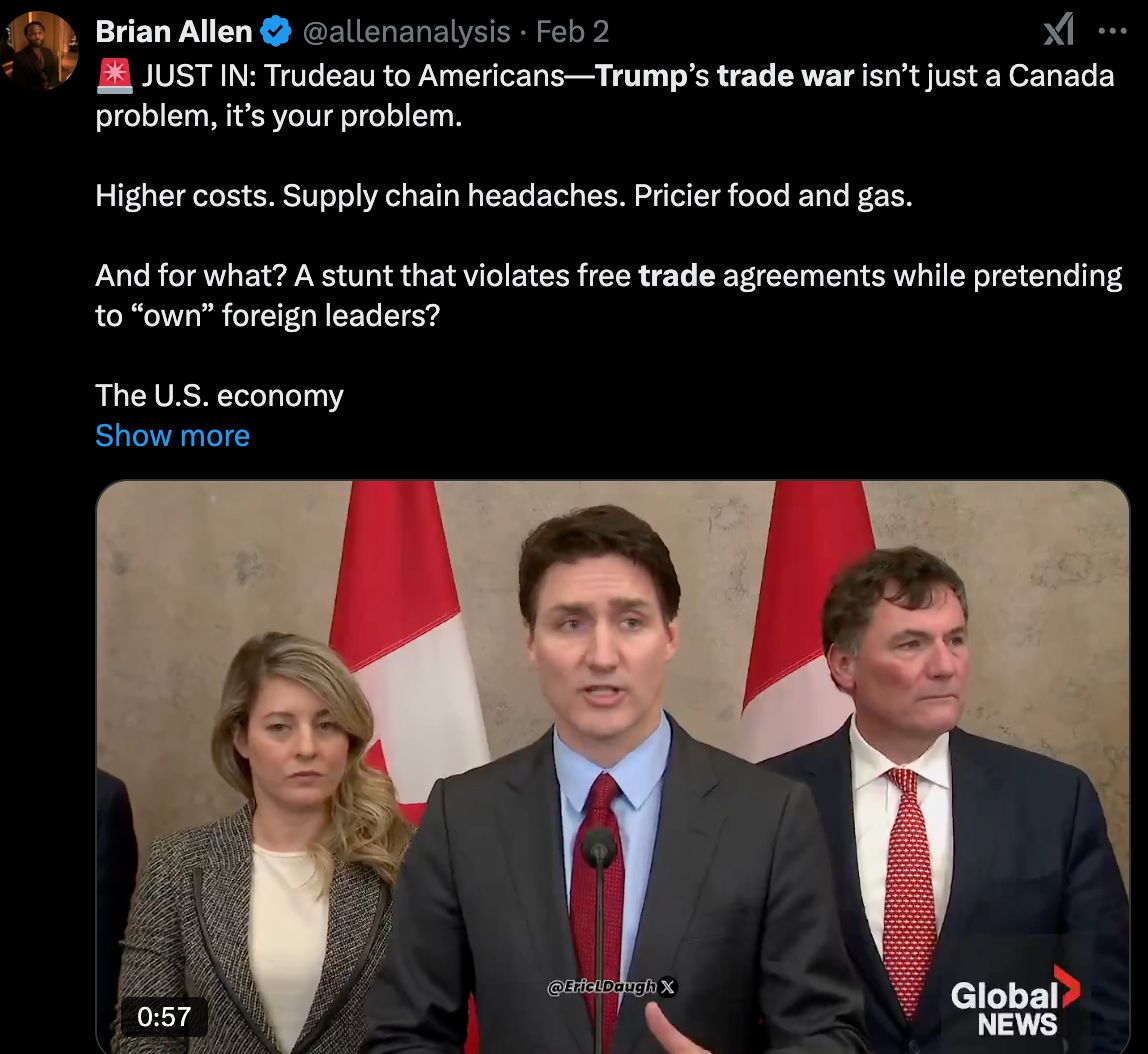
President Claudia Sheinbaum of Mexico ordered retaliatory tariffs and urged dialogue, saying tariffs would not solve the real problems.
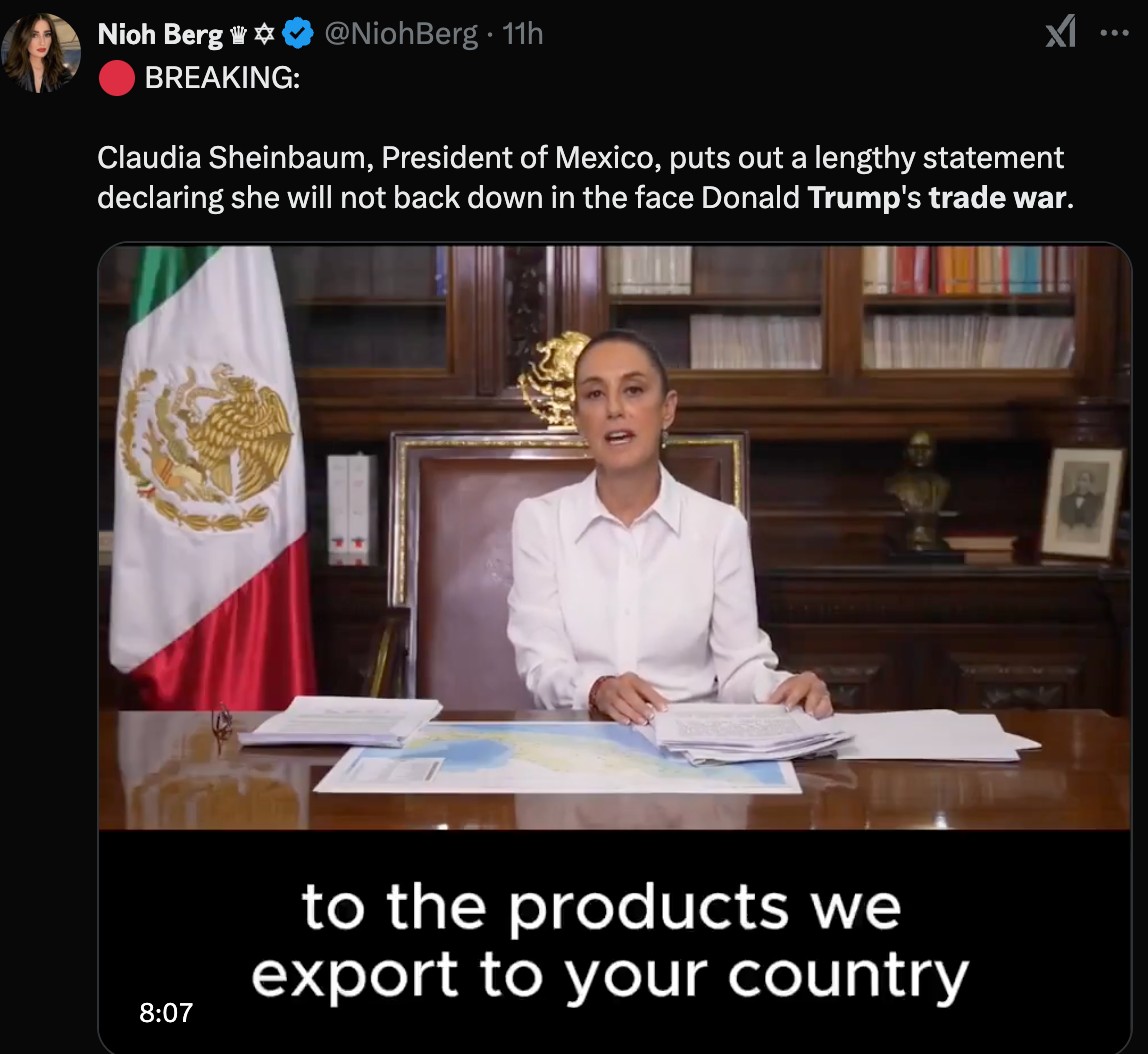
The Chinese Ministry of Commerce condemned the tariffs and announced plans to file a case at the World Trade Organization. It vowed countermeasures to protect China’s interests.
Business reactions
The U.S. Chamber of Commerce warned that tariffs would raise consumer prices and fail to address immigration and drug-related issues.
Expert opinions
Paul Krugman (Economist): Nobel laureate Paul Krugman has been vocal about the detrimental effects of the tariffs. He describes them as "really, really destructive," likening them to "throwing sand in the gears of international commerce and manufacturing." Krugman emphasizes that such policies disrupt global trade and could lead to higher costs for consumers.
Elon Musk (CEO of Tesla and SpaceX): Elon Musk has consistently expressed concerns that trade restrictions can hinder global innovation. He argues that imposing tariffs and similar barriers slows down technological advancement and economic growth by limiting the free exchange of ideas and resources across borders.
Kristalina Georgieva (IMF Chief): Kristalina Georgieva warns that an all-encompassing trade war could significantly decelerate global economic growth. She highlights the risks of escalating trade tensions, noting that they can lead to increased uncertainty, reduced investment, and disruptions in global supply chains, all of which are detrimental to the worldwide economy.
My recommendation to investors is to stay cautious but agile
As a financial expert, I see Trump’s renewed trade war in 2025 as a major disruptor to global markets, particularly in forex and equities. The new tariffs — 25% on Canadian and Mexican imports and 10% on Chinese goods — are already triggering volatility, with the US dollar strengthening sharply against most major and emerging market currencies. The Canadian dollar has hit a 20-year low, while the Mexican peso is sliding rapidly. Investors are flocking to the dollar as a safe haven, making it even harder for countries facing tariffs to stabilize their economies.
Inflation is a key concern. Higher tariffs mean higher prices on imported goods, which could push inflation up in the US and beyond. Central banks, including the Federal Reserve, may have to reassess their monetary policies, possibly tightening rates to control inflation. This could add further strain on emerging markets already struggling with currency depreciation.
Stock markets are feeling the pressure, with sell-offs across European and Asian indices. If this trade war escalates, we could see a significant slowdown in global GDP growth, as supply chains are disrupted and business costs rise. Markets hate uncertainty, and right now, uncertainty is the dominant theme.
My recommendation to investors is to stay cautious but agile. Those involved in forex trading should closely watch USD pairs, as volatility is likely to persist. Diversifying portfolios with safe-haven assets like gold or US Treasuries might be a smart move. Businesses relying on international trade should start evaluating alternative supply chains to mitigate risk. For long-term investors, it’s critical to stay informed and avoid panic-driven decisions.
This trade war will test the resilience of global markets, and those who adapt quickly will be in the best position to navigate the turbulence.
Conclusion
Trump’s 2025 trade war has created widespread economic challenges, affecting currencies, businesses, and global markets. The 25% tariffs on Canada and Mexico and 10% on China have disrupted trade, driving currency volatility in USD/CAD, USD/MXN, and EUR/USD. The Canadian dollar, Mexican peso, and Chinese yuan have weakened as investors seek safer assets.
Canada, Mexico, and China have introduced retaliatory tariffs, further escalating tensions. If trade disputes continue, economic growth may slow, impacting markets worldwide.
The long-term effects will depend on negotiations, market adjustments, and economic resilience. Traders and businesses must stay prepared for continued uncertainty, as global financial stability remains at risk in this rapidly shifting trade environment.
FAQs
Why did Trump impose new tariffs?
The Trump administration argued that tariffs will protect American industries and reduce trade deficits.
How do tariffs impact the Forex market?
Tariffs create economic instability, leading to increased volatility in pairs like CAD/USD, MXN/USD, and EUR/USD.
What should Forex traders watch for next?
Traders should monitor retaliatory tariffs, central bank policies, and economic reports for market direction.
How does the trade war impact everyday consumers?
Consumers will face higher prices on imported goods, as businesses pass additional costs onto customers.
Related Articles
Team that worked on the article
Maxim Nechiporenko has been a contributor to Traders Union since 2023. He started his professional career in the media in 2006. He has expertise in finance and investment, and his field of interest covers all aspects of geoeconomics. Maxim provides up-to-date information on trading, cryptocurrencies and other financial instruments. He regularly updates his knowledge to keep abreast of the latest innovations and trends in the market.
Chinmay Soni is a financial analyst with more than 5 years of experience in working with stocks, Forex, derivatives, and other assets. As a founder of a boutique research firm and an active researcher, he covers various industries and fields, providing insights backed by statistical data. He is also an educator in the field of finance and technology.
As an author for Traders Union, he contributes his deep analytical insights on various topics, taking into account various aspects.
Mirjan Hipolito is a journalist and news editor at Traders Union. She is an expert crypto writer with five years of experience in the financial markets. Her specialties are daily market news, price predictions, and Initial Coin Offerings (ICO).
Forex trading, short for foreign exchange trading, is the practice of buying and selling currencies in the global foreign exchange market with the aim of profiting from fluctuations in exchange rates. Traders speculate on whether one currency will rise or fall in value relative to another currency and make trading decisions accordingly. However, beware that trading carries risks, and you can lose your whole capital.
Benchmark indices, like the S&P 500, track overall market performance; sectoral indices, such as the Nasdaq-100, focus on specific industries; market-cap based indices, like the Russell 2000, classify stocks by size; coverage-based indices span global to country-specific markets; indices by weighting method vary in how they assign component weights; and ethical indices consider ESG factors alongside financial performance.
Bitcoin is a decentralized digital cryptocurrency that was created in 2009 by an anonymous individual or group using the pseudonym Satoshi Nakamoto. It operates on a technology called blockchain, which is a distributed ledger that records all transactions across a network of computers.
Volatility refers to the degree of variation or fluctuation in the price or value of a financial asset, such as stocks, bonds, or cryptocurrencies, over a period of time. Higher volatility indicates that an asset's price is experiencing more significant and rapid price swings, while lower volatility suggests relatively stable and gradual price movements.
An investor is an individual, who invests money in an asset with the expectation that its value would appreciate in the future. The asset can be anything, including a bond, debenture, mutual fund, equity, gold, silver, exchange-traded funds (ETFs), and real-estate property.






























































































































